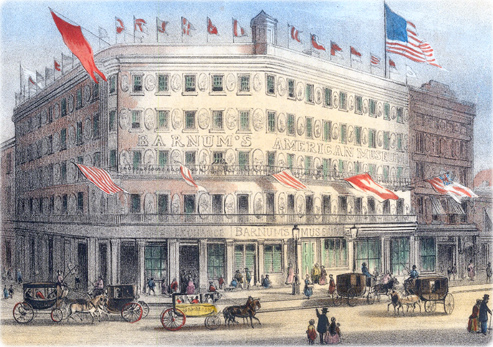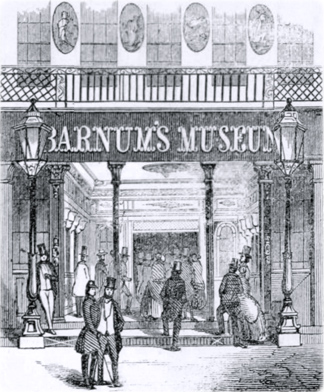
Barnum's American Museum
The Barnum's American Museum was museum and entertainment center located on Broadway, corner of Ann Street, New York City. It operated from 1841 to 1865. Phineas Barnum purchased Scudder's American Museum in 1841.
The origins of this American Museum go back to the Tammany Museum founded in 1790 by the Tammany Society. It was located in a room exhibit in the old City Hall, on Wall Street. Pintard was the trustee and secretary and Gardner Baker was the keeper. In 1793, the museum moved to the old Exchange, on the foot of Broad Street. In 1795, Baker took over the museum. In 1809, John Scudder acquired the collection and opened the American Museum in March 1810 at 21 Chatham Street. In 1817, it moved to the former Alms House building, in the City Hall Park. In 1830, the American Museum moved to its five-story building on the corner of Broadway and Ann Street.
Phineas Taylor Barnum (1810–1891) leased the American Museum in 1841. Barnum was businessman, publisher, politician and showman. He moved to New York City in 1834 and organized the Barnum's Grand Scientific and Musical Theater, a group of theatrical performers, who work and travel together. On April 1841, Barnum returned to New York, after one of these travels, and resolved that he would never again be an itinerant showman. On May 10, he opened an office at the corner of Beekman and Nassau streets, later site of the Nassau Bank, to sell books. From June to September, he leased Vauxhall Garden saloon, but neither was successful and Barnum was in financial trouble.
Then, he learned that the collection of curiosities comprising Scudder's American Museum was for sale. It belonged to the daughters of John Scudder, who had died in 1821. The price asked was $15,000 dollars. It had cost about $50,000. The Museum, however, had been losing money for several years. The Museum building belonged to Francis W. Olmsted, a retired merchant, and Barnum offered to lease it. Barnum also asked Olmsted to purchase the Scudder's collection, but it had already been sold to the directors of Peale's Museum company. Barnum discovered it was an speculative investment involving stockholders and convinced the investors it was bad deal. As a result, the Peale's Museum could make the next pay and lost the investment. Then, Olmsted acquired the collection for $12,000, with Barnum having the right to buy it. On December 1, 1841, the directors of the New York Museum Company (former Peale's Museum company) met with Barnum and offered to hire him to manage the "united museums", which was agreed.
On December 27, 1841, Barnum, then with 21 years old, was in formal possession of the American Museum, which was reopened on January 1, 1842 as the Barnum's American Museum. In the same year, Barnum bought and added to the collection the entire contents of Peale's Museum. At first, the attractions were the collection of curiosities by day and an evening entertainment, consisting of variety performances. There were zoo, museum, lecture hall, wax museum and theater. Advertising strategy was a key to success.
By 1850, the Museum building was enlarged, with a larger front on Broadway. The ground formerly occupied by the Chemical Bank was taken in. The enlarged Lecture Room and new peaces were added to the Picture Gallery. In the same year, Barnum purchased the large Peale collection in Philadelphia. Over the years, Barnum more than doubled the museum's permanent attractions and curiosities, he acquired in 1841.
On July 13, 1865, the American Museum, with its large collection, was destroyed by fire. The fire began in a defective furnace in the cellar in Ann Street and it was first discovered by an employee of the museum at 35 minutes past noon. The site at Ann Street was later occupied by two new buildings: the New York Herald newspaper and Park Bank Building, completed in 1868.
The Barnum's New American Museum opened on September 6, 1865, at 539-541 Broadway, between Spring and Prince streets, but that also burned down, on March 3, 1868. It was after this that Barnum moved on to politics and the circus industry. In 1874, he opened the Roman Hippodrome on the northeast side of Madison Square.

The Barnum's American Museum on Broadway at Ann Street, 1853, after expansion. Hand colored engraving Source: Barry Lawrence Ruderman.

Main entrance to the museum on Broadway (Barnum's American Museum illustrated, 1850).
The Barnum's American Museum in 1848, before enlargement.
Above, the Barnum's American Museum on Broadway at Ann Street, 1855. Fragment of an engraving by Henry Papprill.
by Jonildo Bacelar
Barnum's American Museum

|
Copyright © Geographic Guide - Old NYC. Historic Buildings. |